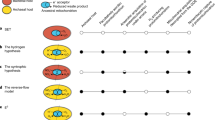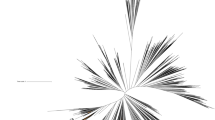Abstract
Nitrate respiration plays an important part in the global nitrogen cycle by initiating a chain of biologically mediated reductions of nitrogen oxides1,2. It involves the substitution of nitrate for oxygen as a terminal electron acceptor, occurs only in the absence of oxygen and is assumed to be performed only by prokaryotic organisms3,4. Here we present evidence for nitrate respiration in eukaryotes. Some Protozoa are known to be capable of living in anoxic water in lakes5,6; we show that in at least one genus of Protozoa (Loxodes) this capacity can be attributed to a dissimilatory nitrate reductase located within the inner mitochondrial membrane. The general acceptance of Loxodes as an extremely primitive protozoon7 strengthens the theory that nitrate-respiring bacteria are plausible ancestors of animal mitochondria8,9.
This is a preview of subscription content, access via your institution
Access options
Subscribe to this journal
Receive 51 print issues and online access
$199.00 per year
only $3.90 per issue
Buy this article
- Purchase on Springer Link
- Instant access to full article PDF
Prices may be subject to local taxes which are calculated during checkout
Similar content being viewed by others
References
Zumft, W. G. & Cardenas, J. Naturwissenschaften 66, 81–88 (1979).
Vincent, W. F., Downes, M. T. & Vincent, C. L. Nature 292, 618–620 (1981).
Carlisle, M. J. in The Eukaryotic Microbial Cell (eds Gooday, G. W., Lloyd, D. & Trinci, A. P. J.) 1–40 (Cambridge University Press, Cambridge, 1980).
Stouthamer, A. H., van't Riet, J. & Oltman, L. F. in Diversity of Bacterial Respiratory Systems Vol. 2 (ed. Knowles, C. J.) 19–48 (CRC, Boca Raton, 1980).
Finlay, B. J. J. gen. Microbiol. 123, 173–178 (1981).
Goulder, R. Hydrobiologia 72, 131–158 (1980).
Corliss, J. D. & Hartwig, E. Mikrofauna Meeresboden 61, 65–88 (1977).
John, P. & Whatley, F. R. Nature 254, 495–498 (1975).
Schwartz, R. M. & Dayhoff, M. D. Science 199, 395–403 (1978).
Cohen, Y. Nature 272, 235–237 (1978).
Rieder, N., Ott, H. A., Pfundstein, P. & Schoch, R. J. Protozool. 29, 15–18 (1982).
Smillie, R. M. in The Biology of Euglena Vol. 2 (ed. Buetow, D. E.) 1–54 (Academic, London, 1968).
Kuntzel, H. & Kochel, H. G. Nature 293, 751–755 (1981).
Weibel, E. R. Int. Rev. Cytol. 26, 235–302 (1969).
Williams, M. A. Quantitative Methods in Biology (North-Holland, Amsterdam, 1977).
Horsley, R. W. in Techniques for the Study of Mixed Populations (eds Lovelock, D. W. & Davies, R.) 71–87 (Academic, London, 1978).
Jones, J. G. Scient. Publs Freshwater Biol. Ass. No. 39, 19–31 (1979).
Luria, S. E. in The Bacteria Vol. 1 (eds Gunsalus, I. C. & Stanier, R. Y.) 1–34 (Academic, London, 1960).
Van'T Riet, J., Stouthamer, A. H. & Planta, R. J. J. Bact. 96, 1455–1464 (1968).
Boonstra, J., Huttunen, M. T. & Konings, W. N. J. biol Chem. 250, 6792–6798 (1975).
Huisman, L. A. & Konings, W. in Sourcebook of Experiments for the Teaching of Microbiology (eds Primrose, S. B. & Wardlow, A. C.) 224–232 (Academic, London, 1982).
Davison, W. Freshwater Biol. 7, 393–401 (1977).
Cunnningham, C. R. & Davison, W. Freshwater Biol. 10, 413–418 (1980).
Mackereth, F. J. H., Heron, J. & Talling, J. F. Scient. Publs Freshwater Biol. Ass. 36, 69–77 (1978).
Jones, J. G. J. gen. Microbiol. 115, 27–35 (1979).
Lowe, R. H. & Evans, H. J. Biochim. biophys. Acta 85, 377–389 (1969).
Bobyleva, N. N. Tsitologiya 23, 1073–1077 (1981).
Author information
Authors and Affiliations
Rights and permissions
About this article
Cite this article
Finlay, B., Span, A. & Harman, J. Nitrate respiration in primitive eukaryotes. Nature 303, 333–336 (1983). https://doi.org/10.1038/303333a0
Received:
Accepted:
Issue Date:
DOI: https://doi.org/10.1038/303333a0
This article is cited by
-
Energetics and evolution of anaerobic microbial eukaryotes
Nature Microbiology (2023)
-
Anaerobic endosymbiont generates energy for ciliate host by denitrification
Nature (2021)
-
Meiofauna increases bacterial denitrification in marine sediments
Nature Communications (2014)
Comments
By submitting a comment you agree to abide by our Terms and Community Guidelines. If you find something abusive or that does not comply with our terms or guidelines please flag it as inappropriate.



